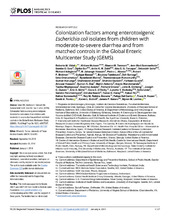Colonization factors among enterotoxigenic Escherichia coli isolates from children with moderate-to-severe diarrhea and from matched controls in the Global Enteric Multicenter Study (GEMS)
Vidal, Roberto M.; Muhsen, Khitam; Tennant, Sharon M.; Svennerholm, Ann-Mari; Sow, Samba O.; Sur, Dipika; Zaidi, Anita K.M.; Faruque, Abu Syed Golam; Saha, Debasish; Adegbola, Richard; Hossain, Mohammad Jahangir; Alonso, Pedro L.; Breiman, Robert F.; Bassat, Quique; Tamboura, Boubou; Sanogo, Doh; Onwuchekwa, Uma; Manna, Byomkesh; Ramamurthy, Thandavarayan; Kanungo, Suman; Ahmed, Shahnawaz; Qureshi, Shahida; Quadri, Farheen; Hossain, Anowar; Das, Sumon K.; Antonio, Martin; Mandomando, Inacio; Nhampossa, Tacilta; Acácio, Sozinho; Omore, Richard; Ochieng, John B.; Oundo, Joseph O.; Mintz, Eric D.; O'Reilly, Ciare E.; Berkeley, Lynette Y.; Livio, Sofie; Panchalingam, Sandra; Nasrin, Dilruba; Farag, Tamer H.; Wu, Yukun; Sommerfelt, Halvor; Robins-Browne, Roy M.; Del Canto, Felipe; Hazen, Tracy H.; Rasko, David A.; Kotloff, Karen L.; Nataro, James Paul; Levine, Myron M.
Peer reviewed, Journal article
Published version

Åpne
Permanent lenke
https://hdl.handle.net/1956/23838Utgivelsesdato
2019-01-04Metadata
Vis full innførselSamlinger
Originalversjon
https://doi.org/10.1371/journal.pntd.0007037Sammendrag
Enterotoxigenic Escherichia coli (“ETEC”) were found to be one of the four most consistently important agents that cause moderate-to-severe diarrhea among children <5 years of age in a large case-control study, the Global Enteric Multicenter Study, performed in four countries in sub-Saharan Africa and three in South Asia. ETEC attach to the lining of the human small intestine by means of protein colonization factors (CFs), after which bacterial toxins stimulate intestinal secretion resulting in diarrhea. Moderate-to-severe diarrhea in young children in developing countries can lead to malnutrition and death. Vaccines are being developed to prevent ETEC diarrhea and its consequences. Several ETEC vaccines aim to stimulate antibodies (protective proteins) that will bind CFs and prevent the bacteria from attaching to intestinal cells, which should, in turn, prevent ETEC diarrhea. Different types of CFs exist. To guide the development of vaccines intending to provide broad protection against ETEC, one must know the frequency with which the different major CFs are produced by ETEC. This paper reports an extensive systematic survey of ETEC CFs and provides helpful information to guide the development of ETEC vaccines.
